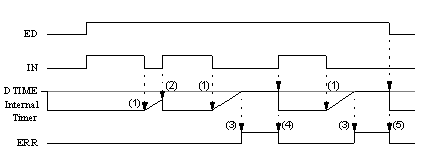If the signal connected to IN becomes "0" and the diagnostics is active, the internal counter will be started.
The deactivation of the diagnostics or of the attachment of the correct input value stops the timer (the requirements may contain errors during the tolerance time DTIME) and sets the timer back to "0".
When the default time at the DTIME input has expired, the ERR output displays an error that remains active until the requirements are "1" or the diagnostic is deactivated.
If the tolerance time DTIME is entered as "0", an error message is immediately returned when the static conditional values (IN) become "0".
An example for process requirement monitoring is given in timing diagram.
Monitoring of process requirements timing diagram
(1)
If IN is "0", the internal timer is started.
(2)
If IN is "1", the internal timer is stopped and reset.
(3)
If the internal timer reaches the DTIME value, an error is reported (ERR becomes "1").
(4)
If IN is "1", the error will be cancelled and the internal timer is stopped and reset.
(5)
When the enable signal ED is "0", the error is cancelled (ERR becomes "0") and the internal timer is stopped and reset. 